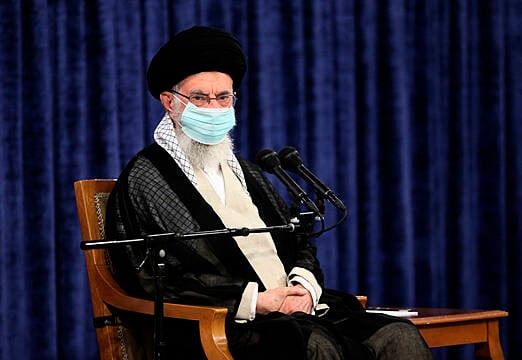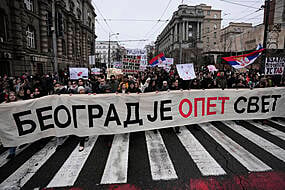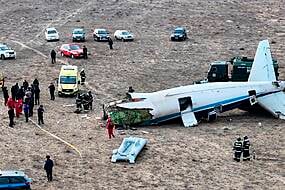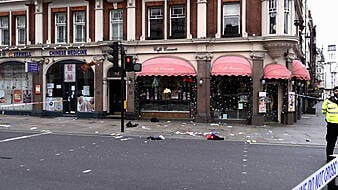A huge fire at a notorious jail that houses political prisoners and anti-government activists in Iran’s capital injured at least nine people, according to state media.
Online videos and local media also reported gunshots, as nationwide protests over the death of 22-year-old Mahsa Amini in police custody entered a fifth week.
Iran’s state-run IRNA news agency, citing a senior security official, reported there were clashes at Evin Prison between inmates in one ward and jail personnel.
The official said prisoners set fire to a warehouse full of uniforms, which caused the blaze. He said the “rioters” were separated from the other inmates to de-escalate the conflict.
The official said the “situation is completely under control” and that firefighters were extinguishing the flames.

Later, Tehran prosecutor Ali Salehi said that “peace” had returned to the prison and that the unrest was not related to the protests which have been sweeping the country.
IRNA later reported that nine people had been injured, without elaborating. It published video showing burnt debris scattered around a building, with firefighters hosing down the embers.
Footage of the fire circulated online. Videos showed shots ringing out as plumes of smoke rose into the sky amid the sound of an alarm.
A protest broke out on the street soon afterwards, with many chanting “Death to the Dictator!” — a reference to Supreme Leader Ayatollah Ali Khamenei – and burning tyres, circulating videos showed.
Witnesses said police blocked roads and highways to Evin prison and that at least three strong explosions were heard coming from the area.

Traffic was heavy along major motorways near the prison, which is in the north of the capital, and many people honked to show their solidarity with protests.
Riot police were seen riding on motorbikes towards the facility, as were ambulances and fire engines. Witnesses reported that the internet was blocked in the area.
The US-based Centre for Human Rights in Iran reported that an “armed conflict” broke out within the prison walls. It said shots were first heard in Ward 7 of the prison. This account could not immediately be corroborated.
The prison fire occurred as protesters intensified anti-government demonstrations along main streets and at universities in some cities across Iran on Saturday. Human rights monitors reported hundreds dead, including children, as the movement concluded its fourth week.
Demonstrators also chanted “Down with the Dictator” on the streets of Ardabil in the country’s north-west.
Students rallied outside universities in Kermanshah, Rasht and Tehran, according to videos on social media.

In the city of Sanandaj, a hotspot for demonstrations in the northern Kurdish region, school girls chanted “Woman, life, freedom” down a central street.
The protests erupted after public outrage over the death Ms Amini following her arrest by Iran’s morality police in Tehran for violating the Islamic Republic’s strict dress code.
Iran’s government insists she was not mistreated in police custody, but her family says her body showed bruises and other signs of beating after she was detained.
At least 233 protesters have been killed since demonstrations swept Iran on September 17, according to US-based rights monitor HRANA. The group said 32 among the dead were below the age of 18.
Earlier, Oslo-based Iran Human Rights estimated 201 people have been killed. Iranian authorities have provided no death toll for weeks.
Iranian authorities have alleged without providing evidence that the unrest is a Western plot, trying to play down the demonstrations.
Public anger in Iran has coalesced around Ms Amini’s death, prompting girls and women to remove their mandatory headscarves on the street in a show of solidarity.
Other segments of society, including oil workers, have also joined the movement, becoming one of the greatest challenges to Iran’s theocracy since the country’s 2009 Green Movement.
Riots have also broken out in prisons, with clashes reported between inmates and guards in Lakan prison in the northern province of Gilan recently.

Evin Prison, which holds detainees facing security-related charges including dual citizens, has been charged by rights groups with abusing inmates. The facility has long been known for holding political prisoners as well as those with ties to the West who have been used by Iran as bargaining chips in international negotiations.
Siamak Namazi, an Iranian-American who had been furloughed from prison while serving a 10-year sentence on internationally criticised spying charges, was recently sent back into Evin. His 85-year-old father, Baquer Namazi, was freed and allowed to leave the country.
A lawyer for Siamak Namazi, Jared Genser, wrote on Twitter early on Sunday that he “is safe and has been moved to a secure area of Evin Prison”. He did not elaborate.
In 2018, the prison was slapped with US sanctions.
“Prisoners held at Evin Prison are subject to brutal tactics inflicted by prison authorities, including sexual assaults, physical assaults and electric shock,” the US Treasury Department wrote in a statement after announcing the sanctions in 2018.
The US State Department was following the reports “with urgency” and was in contact with the Swiss as the protecting power for the US, spokesman Ned Price said in a tweet on Saturday. “Iran is fully responsible for the safety of our wrongfully detained citizens, who should be released immediately.”

President Joe Biden, on a trip to Oregon, said the Iranian “government is so oppressive” and that he has an “enormous amount of respect for people marching in the streets”.
Commercial strikes resumed on Saturday in key cities across the Kurdish region, including Saqqez, Ms Amini’s hometown, and the birthplace of the protests, Bukan and Sanandaj.
The government has responded with a brutal crackdown, arresting activists and protest organisers, reprimanding Iranian celebrities for voicing support, even confiscating their passports, and using live ammunition, tear gas and sound bombs to disperse crowds, leading to deaths.
In a video widely distributed on Saturday, plainclothes Basij, a paramilitary volunteer group, are seen forcing a woman into a car and firing bullets into the air amid a protest in Gohardasht, in northern Iran.
Widespread internet outages have also made it difficult for protesters to communicate with the outside world, while Iranian authorities have detained at least 40 journalists since the unrest began, according to the Committee to Protect Journalists.







